HUD industry research: rapid adoption of OEM HUD in vehicles is under way and Chinese auto brands perform well.
Head-up display (HUD) projects key information onto the transparent media or windshield before the driver for him/her to look down on the cluster and navigation less frequently. So far there have been three types of HUDs mass-produced: C-HUD, W-HUD and AR-HUD.
In 2025, the penetration of OEM HUD in China will outstrip 30%.
According to our statistics, in 2020, 692,000 passenger cars in China packed OEM HUDs, an annualized spurt of 101.2%, with the penetration up to 3.7%, 2.0 percentage points higher than the previous year. In 2021, the penetration of HUD sustains growth and is expected to be 8% or so at the end of the year, compared with nearly 5% in the first half. It is conceivable that the figure will exceed 30% in 2025.
Three reasons stand out. First, larger size and more information displayed make HUD a third screen for an intelligent cockpit, which is accompanied by higher level of vehicle intelligence and upgrade of projection technology. Second, Chinese leading automakers like Great Wall Motor, Geely, Hongqi and NIO quicken their pace of applying HUDs in their vehicles, and lower their prices to the range of RMB100,000 to RMB150,000. Third, the production-ready AR-HUD will boom in the 3 or 5 years to come.
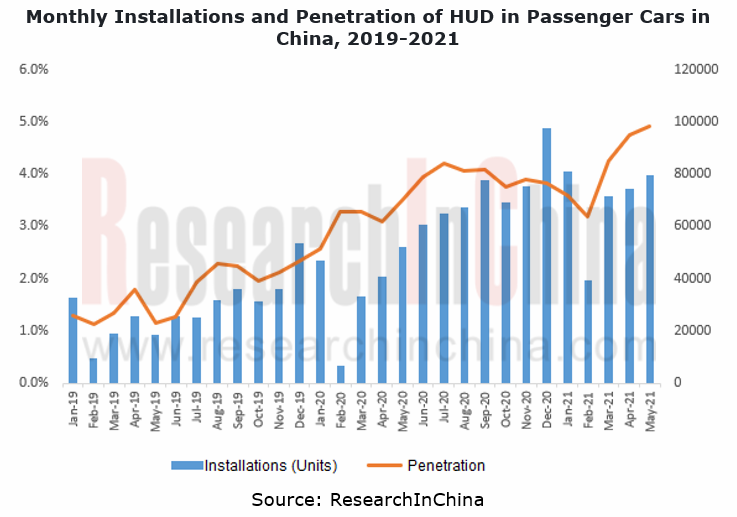
OEMs work hard on W-HUD and push on with increasing installations.
At present, W-HUD as the mainstream solution of automakers is encroaching on the C-HUD market. Our data show that in 2020, W-HUD swept 91.8% of total HUD installations, up 10.2 percentage points year on year. As the technology matures, AR-HUD, which has become available on market in small batches from 2021, will be neck and neck with W-HUD, together driving up HUD installations.
In future, W-HUD will evolve from an optional configuration for high-class vehicles to a standard one for medium & low class. Chinese auto brands play a crucial role in this process. Since 2020, the likes of Hongqi, Haval, Geely, Lynk & Co and Geometry have been the main drivers of W-HUD in China. The prices of HUD-enabled models like Geely Preface, Haval Big Dog and Haval First Love have been lowered to RMB150,000.
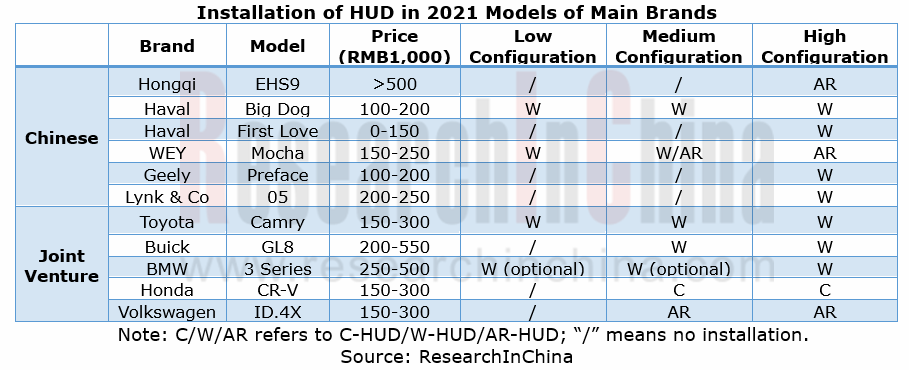
Mass production of AR-HUD starts, and TFT solution becomes the first choice.
AR-HUD displays real road conditions. The combination of ADAS functions such as LKA and ACC provides immersive experience for drivers, which is a future trend for HUD.
In September 2020, Mercedes-Benz S-Class with AR-HUD made a debut, establishing the age of mass-produced AR-HUD. And then models including Audi Q4 e-tron, Volkswagen ID Series, FAW Hongqi and Great Wall WEY have been competing to offer AR-HUD-enabled versions.
In addition, Hyundai Kia, Hyundai Aini Krypton, GAC, Changan Auto and Chery, among others, plan to equip their new cars with AR-HUD. For example, AR-HUD co-developed by GAC and Foryou Group is to be first mounted on a mass-produced model in the fourth quarter of 2021.
Through the lens of solutions, AR-HUDs spawned so far generally use TFT and DLP technologies. By comparison, TFT costs less so Chinese models prefer this technology; despite high cost, DLP technology that works very well finds application in some highly-configured or top-class models (e.g., Mercedes-Benz S-Class with selling price higher than RMB800,000).
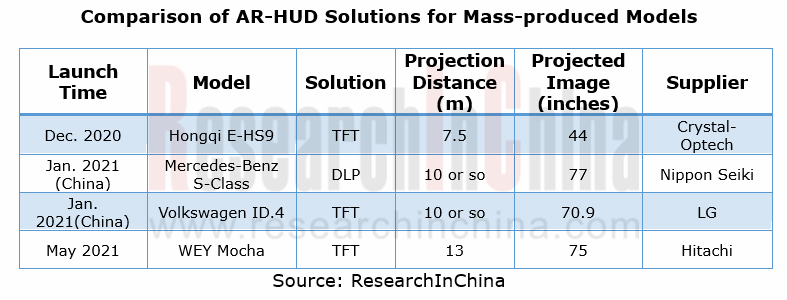
WEY Mocha: launched in May 2021, the model carries AR-HUD which delivers 13m projection distance and 75-inch image where speed, fuel level, distance (to destination), direction, etc. are shown. The device also enhances annotations to lane lines and displays the dynamic distance with other vehicles, with dynamic arrows appearing for guidance when turning or U-turning.

Volkswagen: the automaker has rolled out several AR-HUD-enabled models such as ID.4 and ID.6 since 2021, all of which use TFT projection technology. Differing from WEY Mocha and other China-made cars, these Volkswagen models feature double-layer display design in which the upper layer is AR field where driving assistance information and navigation tips are displayed in the form of dynamic 3D rendering, with virtual image distance (VID) up to 10m and display field diameter of 1.8m (about 70.9 inches); the lower layer is status field displaying speed, navigation, road signs, destination, etc., with VID of 3m.
Things come in pairs. Both Mercedes-Benz and Audi also adopt such display design, which makes images enhanced in much better virtual effects.
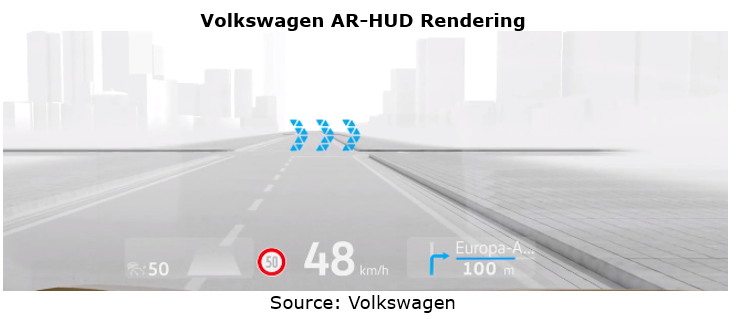
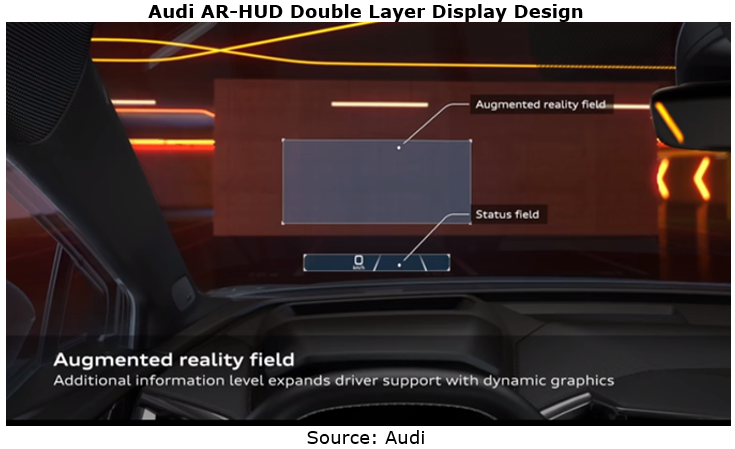
The rising Chinese suppliers pin great hope on AR-HUD.
Nippon Seiki, Denso and Continental have a monopoly on the Chinese HUD market. They target mid- and high-end brands such as BMW, Audi, Mercedes-Benz, Mazda, Toyota, Honda and Buick.
In China, local suppliers like Foryou Multimedia Electronics, Jiangsu New Vision Automotive Electronics and E-Lead Electronic serve domestic automakers including Geely, Hongqi, Great Wall Motor, NIO and Dongfeng Motor.
As AR-HUD comes into being, almost all suppliers gravitate towards it, but local players are more motivated.
Nippon Seiki: the world’s largest HUD supplier boasts annual capacity of nearly 2 million units. In 2020, it was the first one to provide AR-HUD for Mercedes-Benz S-Class. In 2021, it is working hard on construction and layout of HUD production bases in China.
Foryou Multimedia Electronics: as of June 2021, the supplier has shipped a total of 200,000 HUDs which have been used in multiple models of Great Wall Motor, GAC, BAIC, Dongfeng Nissan and Changan Auto. The company has secured designated AR-HUD projects from GAC and others that plan installation in their vehicles in 2021. It is also developing double layer AR-HUD, with the maximum and minimum VID up to 10m and 2.4m, respectively.
Huawei: in April 2021, Huawei unveiled an AR-HUD based on LCOS projection technology, offering 7.5m VID, 13°x 5° FOV and 70-inch image. The device is just 10L much smaller than DLP HUD, and puts projections directly onto the windshield, with no need for special treatment of the windshield.
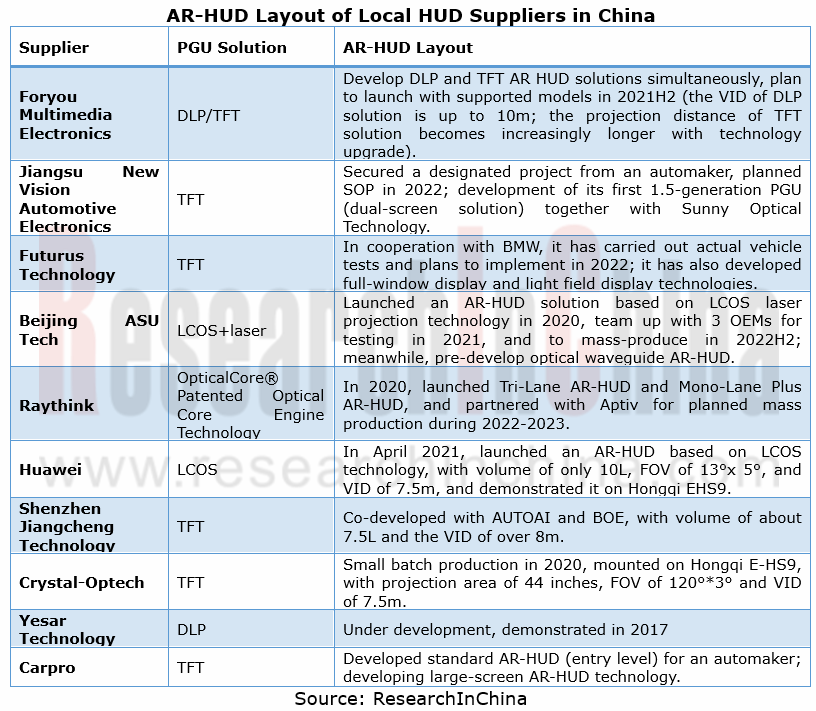
Giants race to deploy new-generation holographic technology.
Current mass-produced AR-HUDs still adopt the geometrical optical projection solution that W-HUD uses, which means an ultra-large aspheric mirror is needed to increase the projection distance (AR-HUD VID is required to be over 10m). Thus the package size is so large that OEMs cannot use.
Holographic technology (optical waveguide, HOE, CGH, etc.) which not only reduces the size of the device but widens FOV has been a hot spot for suppliers and automakers.
In September 2020, DigiLens, an optical waveguide start-up, 18% owned by Continental, introduced its CrystalClear? AR HUD based on DigiLens’ proprietary photopolymer material, with the largest FOV up to 15°x5°, luminance of 12,000 nits and package size of just 5 liters, allowing it to fit into most vehicles and displaying images at infinity.
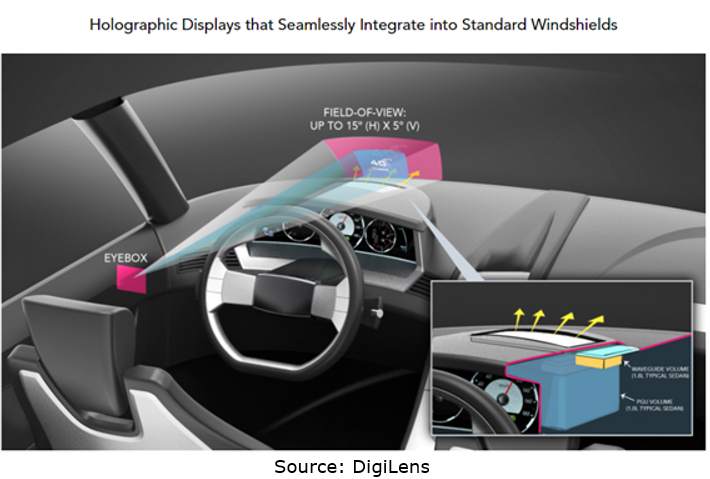
In January 2021, Panasonic together with Envisics rolled out an AR-HUD based on laser holographic technology. Using eye tracking and vibration control technologies, the HUD offers VID up to 10m, FOV of 10°×4°, and image resolution as high as 4K, displaying speed, fuel level, etc. in the near field and navigation in the far field.
Envisics, founded in 2018 and based in the UK, is developing holographic AR-HUD for over ten companies such as Hyundai Mobis, General Motors and SAIC. Its new technology will be the first used in Cadillac’s mass-produced models in 2023.
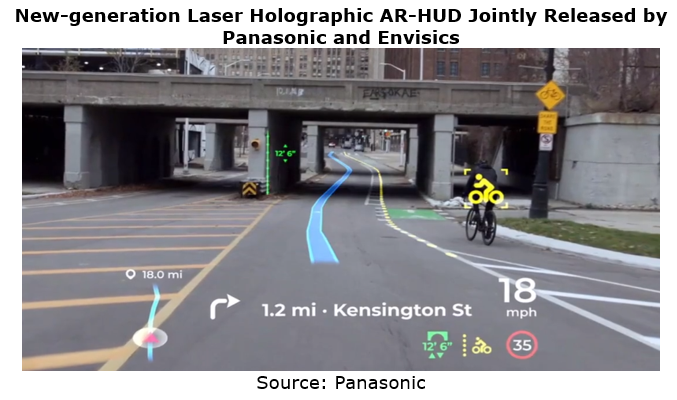
In July 2021, VividQ, a computer-generated holographic technology (CGH) firm, raised USD15 million in its seed funding round led by UTokyo IPC, the venture investment arm for the University of Tokyo. Its holographic technology will be first applied to automotive HUD for OEMs in China in early 2022.
Moreover, Hyundai/Porsche (investing WayRay), Denso/Intel (investing CY Vision) and BAIC (partnering with Sanji Optoelectronics) are deploying holographic technology as well.
Autonomous Driving Domain Controller and Central Computing Unit (CCU) Industry Report, 2025
Research on Autonomous Driving Domain Controllers: Monthly Penetration Rate Exceeded 30% for the First Time, and 700T+ Ultrahigh-compute Domain Controller Products Are Rapidly Installed in Vehicles
L...
China Automotive Lighting and Ambient Lighting System Research Report, 2025
Automotive Lighting System Research: In 2025H1, Autonomous Driving System (ADS) Marker Lamps Saw an 11-Fold Year-on-Year Growth and the Installation Rate of Automotive LED Lighting Approached 90...
Ecological Domain and Automotive Hardware Expansion Research Report, 2025
ResearchInChina has released the Ecological Domain and Automotive Hardware Expansion Research Report, 2025, which delves into the application of various automotive extended hardware, supplier ecologic...
Automotive Seating Innovation Technology Trend Research Report, 2025
Automotive Seating Research: With Popularization of Comfort Functions, How to Properly "Stack Functions" for Seating?
This report studies the status quo of seating technologies and functions in aspe...
Research Report on Chinese Suppliers’ Overseas Layout of Intelligent Driving, 2025
Research on Overseas Layout of Intelligent Driving: There Are Multiple Challenges in Overseas Layout, and Light-Asset Cooperation with Foreign Suppliers Emerges as the Optimal Solution at Present
20...
High-Voltage Power Supply in New Energy Vehicle (BMS, BDU, Relay, Integrated Battery Box) Research Report, 2025
The high-voltage power supply system is a core component of new energy vehicles. The battery pack serves as the central energy source, with the capacity of power battery affecting the vehicle's range,...
Automotive Radio Frequency System-on-Chip (RF SoC) and Module Research Report, 2025
Automotive RF SoC Research: The Pace of Introducing "Nerve Endings" such as UWB, NTN Satellite Communication, NearLink, and WIFI into Intelligent Vehicles Quickens
RF SoC (Radio Frequency Syst...
Automotive Power Management ICs and Signal Chain Chips Industry Research Report, 2025
Analog chips are used to process continuous analog signals from the natural world, such as light, sound, electricity/magnetism, position/speed/acceleration, and temperature. They are mainly composed o...
Global and China Electronic Rearview Mirror Industry Report, 2025
Based on the installation location, electronic rearview mirrors can be divided into electronic interior rearview mirrors (i.e., streaming media rearview mirrors) and electronic exterior rearview mirro...
Intelligent Cockpit Tier 1 Supplier Research Report, 2025 (Chinese Companies)
Intelligent Cockpit Tier1 Suppliers Research: Emerging AI Cockpit Products Fuel Layout of Full-Scenario Cockpit Ecosystem
This report mainly analyzes the current layout, innovative products, and deve...
Next-generation Central and Zonal Communication Network Topology and Chip Industry Research Report, 2025
The automotive E/E architecture is evolving towards a "central computing + zonal control" architecture, where the central computing platform is responsible for high-computing-power tasks, and zonal co...
Vehicle-road-cloud Integration and C-V2X Industry Research Report, 2025
Vehicle-side C-V2X Application Scenarios: Transition from R16 to R17, Providing a Communication Base for High-level Autonomous Driving, with the C-V2X On-board Explosion Period Approaching
In 2024, t...
Intelligent Cockpit Patent Analysis Report, 2025
Patent Trend: Three Major Directions of Intelligent Cockpits in 2025
This report explores the development trends of cutting-edge intelligent cockpits from the perspective of patents. The research sco...
Smart Car Information Security (Cybersecurity and Data Security) Research Report, 2025
Research on Automotive Information Security: AI Fusion Intelligent Protection and Ecological Collaboration Ensure Cybersecurity and Data Security
At present, what are the security risks faced by inte...
New Energy Vehicle 800-1000V High-Voltage Architecture and Supply Chain Research Report, 2025
Research on 800-1000V Architecture: to be installed in over 7 million vehicles in 2030, marking the arrival of the era of full-domain high voltage and megawatt supercharging.
In 2025, the 800-1000V h...
Foreign Tier 1 ADAS Suppliers Industry Research Report 2025
Research on Overseas Tier 1 ADAS Suppliers: Three Paths for Foreign Enterprises to Transfer to NOA
Foreign Tier 1 ADAS suppliers are obviously lagging behind in the field of NOA.
In 2024, Aptiv (2.6...
VLA Large Model Applications in Automotive and Robotics Research Report, 2025
ResearchInChina releases "VLA Large Model Applications in Automotive and Robotics Research Report, 2025": The report summarizes and analyzes the technical origin, development stages, application cases...
OEMs’ Next-generation In-vehicle Infotainment (IVI) System Trends Report, 2025
ResearchInChina releases the "OEMs’ Next-generation In-vehicle Infotainment (IVI) System Trends Report, 2025", which sorts out iterative development context of mainstream automakers in terms of infota...